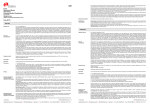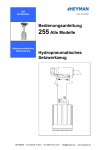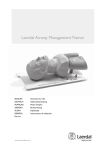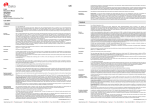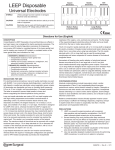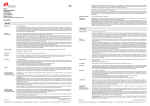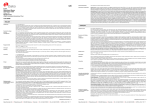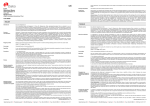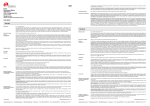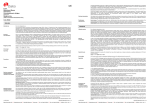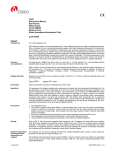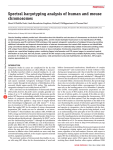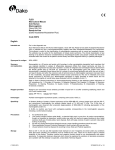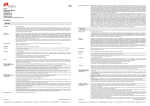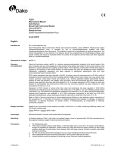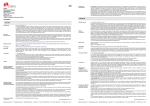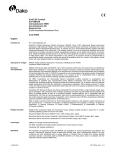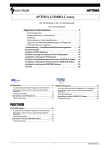Download FLEX Monoclonal Mouse Anti-Human Cytokeratin 18 Clone
Transcript
Positive and negative controls should be run simultaneously using the same protocol as the patient specimens. The positive control tissue should include liver and the cells/structures should display reaction patterns as described for this tissue in “Performance characteristics” in all positive specimens. The recommended negative control reagent is FLEX Negative Control, Mouse, (Dako Autostainer/Autostainer Plus) (Code IS750). FLEX Monoclonal Mouse Anti-Human Cytokeratin 18 Clone DC 10 Ready-to-Use (Dako Autostainer/Autostainer Plus) Staining interpretation Cells labeled by the antibody display cytoplasmic staining. Code IS618 ENGLISH Intended use For in vitro diagnostic use. FLEX Monoclonal Mouse Anti-Human Cytokeratin 18, Clone DC 10, Ready-to-Use (Dako Autostainer/Autostainer Plus), is intended for use in immunohistochemistry together with Dako Autostainer/Autostainer Plus instruments. This antibody labels epithelial cells in those epithelia expressing cytokeratin 18, and hence the antibody is a useful tool for the differentiation and identification of epithelial tumors (1) and epithelioid hemangioendotheliomas (2). Antibodies to cytokeratin 18 may also be useful for the identification of seminomas (3). The clinical interpretation of any staining or its absence should be complemented by morphological studies using proper controls and should be evaluated within the context of the patient’s clinical history and other diagnostic tests by a qualified pathologist. Summary and explanation Cytokeratin 18 belongs to the intermediate filaments, which create a cytoskeleton in almost all cells. In contrast to other intermediate filaments, cytokeratins (CKs) are made up of a highly complex multigene family of polypeptides with molecular masses ranging from 40 to 68 kDa. Until now, 20 distinct CK polypeptides (4, 5) have been revealed in various human epithelial cells (6). They can be divided into an acidic (type I) and a neutral-basic (type II) subfamily. CK18, a 45 kDa protein, belongs to the acidic type of cytokeratins, and is typically expressed in simple, nonstratified epithelia. However, CK18 is also expressed in basal and superficial cells of transitional epithelium as well as in the luminal/secretory cells of complex epithelia (6). Refer to Dako’s General Instructions for Immunohistochemical Staining or the detection system instructions of IHC procedures for: 1) Principle of Procedure, 2) Materials Required, Not Supplied, 3) Storage, 4) Specimen Preparation, 5) Staining Procedure, 6) Quality Control, 7) Troubleshooting, 8) Interpretation of Staining, 9) General Limitations. Reagent provided Ready-to-use monoclonal mouse antibody provided in liquid form in a buffer containing stabilizing protein and 0.015 mol/L sodium azide. Clone: DC 10 (7). Isotype: IgG1, kappa. Immunogen PCM 42, human breast carcinoma cell line (7). Specificity In Western blotting of cytokeratin preparations from BT 20 cells, the antibody labels a single band of 45 kDa corresponding to CK18 (7). In immunocytochemistry on human cultured cell lines, the antibody labels tumor cells of epithelial origin, whereas normal fibroblasts and tumor cells of non-epithelial origin such as glioma, melanoma and osteosarcoma, are not labeled (7). Precautions 1. For professional users. 2. This product contains sodium azide (NaN3), a chemical highly toxic in pure form. At product concentrations, though not classified as hazardous, sodium azide may react with lead and copper plumbing to form highly explosive build-ups of metal azides. Upon disposal, flush with large volumes of water to prevent metal azide build-up in plumbing. 3. As with any product derived from biological sources, proper handling procedures should be used. 4. Wear appropriate Personal Protective Equipment to avoid contact with eyes and skin. 5. Unused solution should be disposed of according to local, State and Federal regulations. Storage Store at 2–8 °C. Do not use after expiration date s tamped on vial. If reagents are stored under any conditions other than those specified, the conditions must be verified by the user. There are no obvious signs to indicate instability of this product. Therefore, positive and negative controls should be run simultaneously with patient specimens. If unexpected staining is observed which cannot be explained by variations in laboratory procedures and a problem with the antibody is suspected, contact Dako Technical Support. Specimen preparation including materials required but not supplied The antibody can be used for labeling formalin-fixed, paraffin-embedded tissue sections. Tissue specimens should be cut into sections of approximately 4 µm. Pre-treatment with heat-induced epitope retrieval (HIER) is required using Dako PT Link (Code PT100/PT101). For details, please refer to the PT Link User Guide. Optimal results are obtained by pretreating tissues using EnVision FLEX Target Retrieval Solution, High pH (50x) (Code K8010/K8004). Paraffin-embedded sections: Pre-treatment of formalin-fixed, paraffin-embedded tissue sections is recommended using the 3-in-1 specimen preparation procedure for Dako PT Link. Follow the pre-treatment procedure outlined in the package insert for EnVision FLEX Target Retrieval Solution, High pH (50x) (Code K8010/K8004). Note: After staining the sections must be dehydrated, cleared and mounted using permanent mounting medium. Deparaffinized sections: Pre-treatment of deparaffinized formalin-fixed, paraffin-embedded tissue sections is recommended using Dako PT Link and following the same procedure as described for paraffin-embedded sections. After staining the slides should be mounted using aqueous or permanent mounting medium. The tissue sections should not dry out during the treatment or during the following immunohistochemical staining procedure. For greater adherence of tissue sections to glass slides, the use of FLEX IHC Microscope Slides (Code K8020) is recommended. Staining procedure including materials required but not supplied The recommended visualization system is EnVision FLEX, High pH, (Dako Autostainer/Autostainer Plus) (Code K8010). The staining steps and incubation times are preprogrammed into the software of Dako Autostainer/Autostainer Plus instruments, using the following protocols: Template protocol: FLEXRTU2 (200 µL dispense volume) or FLEXRTU3 (300 µL dispense volume) Autoprogram: CK18 (without counterstaining) or CK18H (with counterstaining) The Auxiliary step should be set to “rinse buffer” in staining runs with ≤10 slides. For staining runs with >10 slides the Auxiliary step should be set to “none”. This ascertains comparable wash times. All incubation steps should be performed at room temperature. For details, please refer to the Operator’s Manual for the dedicated instrument. If the protocols are not available on the used Dako Autostainer instrument, please contact Dako Technical Services. Optimal conditions may vary depending on specimen and preparation methods, and should be determined by each individual laboratory. If the evaluating pathologist should desire a different staining intensity, a Dako Application Specialist/Technical Service Specialist can be contacted for information on re-programming of the protocol. Verify that the performance of the adjusted protocol is still valid by evaluating that the staining pattern is identical to the staining pattern described in “Performance characteristics”. Counterstaining in hematoxylin is recommended using EnVision FLEX Hematoxylin, (Dako Autostainer/Autostainer Plus) (Code K8018). Non-aqueous, permanent mounting medium is recommended. (115280-003) Dako Denmark A/S IS618/EFG/MNI/2009.12.04 p. 1/4 | Produktionsvej 42 | DK-2600 Glostrup | Denmark | Tel. +45 44 85 95 00 | Fax +45 44 85 95 95 | CVR No. 33 21 13 17 Performance characteristics Normal tissues: In general, the antibody labels simple epithelia and transitional epithelium as opposed to stratified epithelial components, which are negative. The labeling includes simple epithelia from the intestine, bronchial tree and alveoli of the respiratory system, kidney tubuli, bile ducts, surface mucosa of endometrium and endocervix, Fallopian tube epithelium, and rete epithelium of testis and ovary. Furthermore, hepatocytes and pancreatic acini are labeled by the antibody. In addition, the antibody labels the complex glandular epithelia of breast-, salivary-, and sweat glands, as well as the transitional epithelium of the urinary bladder (7). Also the epithelial cells of the periodontium are labeled (8). Of non-epithelial cells, the antibody labels endothelial cells in venules, lymphatics and capillaries in such tissues as skin, subcutaneous soft tissues, skeletal muscle, placenta, and, e.g. respiratory, gastrointestinal, and genital tract mucosa (2). No labeling is observed in epithelial tissues which are known to lack CK18, e.g. epidermis, foot sole epidermis, vagina, exocervix, esophagus, and myoepithelial cells (7). In liver, the gall epithelial cells show a moderate to strong staining reaction, whereas the membranes of the liver cells show a weak to moderate staining reaction. Abnormal tissues: In tumors of pancreas, the antibody labeled 6/6 acinar cell carcinomas, 1/1 pancreatoblastoma, 19/20 pancreatic neuroendocrine tumors, and 10/19 solidpseudopapillary tumors (9). Furthermore, the antibody labeled 30/30 biphasic-, 21/46 monophasic- and 8/17 poorly differentiated synovial sarcomas (10). In vascular tumors, the antibody labeled endothelial cells in 17/17 epithelioid hemangioendotheliomas, 9/14 epithelioid angiosarcomas, 6/10 spindle-cell hemangiomas, 2/7 lymphangiomas, 10/48 non-epithelioid angiosarcomas, 3/13 venous hemangiomas, and 1/18 capillary hemangiomas. No labeling was observed in 4 cavernous hemangiomas and 6 Kaposi´s sarcomas (2). Testing of the antibody on seminoma, small cell lung carcinoma, Merkel cell carcinoma and invasive breast carcinoma showed positive reaction. FRANÇAIS Utilisation prévue Pour utilisation diagnostique in vitro. FLEX Monoclonal Mouse Anti-Human Cytokeratin 18, Clone DC 10, Ready-to-Use, (Dako Autostainer/Autostainer Plus) est destiné à une utilisation en immunohistochimie avec les instruments Dako Autostainer/Autostainer Plus. Cet anticorps marque les cellules épithéliales des épithéliums exprimant la cytokératine 18, et par conséquent, facilite la différenciation et l’identification des tumeurs épithéliales (1) et des hémangio-endothéliomes épithélioïdes (2). Les anticorps dirigés contre la cytokératine 18 peuvent également s’avérer utiles dans l’identification des séminomes (3). L’interprétation clinique de toute coloration ou son absence doit être complétée par des études morphologiques en utilisant des contrôles appropriés et doit être évaluée en fonction des antécédents cliniques du patient et d’autres tests diagnostiques par un pathologiste qualifié. Résumé et explication La cytokératine 18 fait partie des filaments intermédiaires, qui créent un cytosquelette dans presque toutes les cellules. À la différence des autres filaments intermédiaires, les cytokératines (CK) sont constituées d’une famille multigénique hautement complexe de polypeptides dont les poids moléculaires varient entre 40 et 68 kDa. À ce jour, vingt polypeptides de CK distincts (4, 5) ont été identifiés dans diverses cellules épithéliales humaines (6). Les CK peuvent être divisées en sous-familles : type I acide et type II neutre-basique. La CK18, une protéine de 45 kDa, appartient aux cytokératines de type acide, et est généralement exprimée dans les épithéliums simples, non stratifiés. Cependant, la CK18 est également exprimée dans les cellules basales et superficielles de l’épithélium transitionnel, ainsi que dans les cellules luminales/sécrétoires des épithéliums complexes (6). Se référer aux Instructions générales de coloration immunohistochimique de Dako ou aux instructions du système de détection relatives aux procédures IHC pour plus d’informations concernant les points suivants : 1) Principe de procédure, 2) Matériels requis mais non fournis, 3) Conservation, 4) Préparation des échantillons, 5) Procédure de coloration, 6) Contrôle qualité, 7) Dépannage, 8) Interprétation de la coloration, 9) Limites générales. Réactifs fournis Anticorps monoclonal de souris prêt à l’emploi fourni sous forme liquide dans un tampon contenant une protéine stabilisante et 0,015 mol/L d’azide de sodium. Clone : DC 10 (7). Isotype : IgG1, kappa. Immunogène PCM 42, lignée cellulaire de carcinome mammaire humain (7). Spécificité Lors d’analyses par Western blot de préparations de cytokératine de cellules BT 20, l’anticorps marque une seule bande de 45 kDa correspondant à la CK18 (7). En immunocytochimie sur les lignées de cultures cellulaires humaines, l’anticorps marque les cellules tumorales d’origine épithéliale, alors que les fibroblastes normaux et les cellules tumorales d’origine non épithéliale (ex. : gliomes, mélanomes et ostéosarcomes) ne sont pas marqués (7). Précautions 1. Pour utilisateurs professionnels. 2. Ce produit contient de l’azide de sodium (NaN3), produit chimique hautement toxique dans sa forme pure. Aux concentrations du produit, bien que non classé comme dangereux, l’azide de sodium peut réagir avec le cuivre et le plomb des canalisations et former des accumulations d’azides métalliques hautement explosifs. Lors de l’élimination, rincer abondamment à l’eau pour éviter toute accumulation d’azide métallique dans les canalisations. 3. Comme avec tout produit d’origine biologique, des procédures de manipulation appropriées doivent être respectées. 4. Porter un vêtement de protection approprié pour éviter le contact avec les yeux et la peau. 5. Les solutions non utilisées doivent être éliminées conformément aux réglementations locales et nationales. Conservation Conserver entre 2 et 8 °C. Ne pas utiliser après la date de péremption indiquée sur le flacon. Si les réactifs sont conservés dans des conditions autres que celles indiquées, celles-ci doivent être validées par l’utilisateur. Il n’y a aucun signe évident indiquant l’instabilité de ce produit. Par conséquent, des contrôles positifs et négatifs doivent être testés en même temps que les échantillons de patient. Si une coloration inattendue est observée, qui ne peut être expliquée par un changement des procédures du laboratoire, et en cas de suspicion d’un problème lié à l’anticorps, contacter l’assistance technique de Dako. Préparation des échantillons y compris le matériel requis mais non fourni L’anticorps peut être utilisé pour le marquage des coupes de tissus inclus en paraffine et fixés au formol. L’épaisseur des coupes d’échantillons de tissu doit être d’environ 4 µm. Un prétraitement avec démasquage d’épitope induit par la chaleur (HIER) est nécessaire avec le Dako PT Link (Réf. PT100/PT101). Pour plus de détails, se référer au Guide d’utilisation du PT Link. Des résultats optimaux sont obtenus en prétraitant les tissus à l’aide de la EnVision FLEX Target Retrieval Solution, High pH (50x) (Réf. K8010/K8004). Coupes incluses en paraffine : le prétraitement des coupes tissulaires fixées au formol et incluses en paraffine est recommandé à l'aide de la procédure de préparation d'échantillon 3-en-un pour le Dako PT Link. Suivre la procédure de prétraitement indiquée dans la notice de la EnVision FLEX Target Retrieval Solution, High pH (50x) (Réf. K8010/K8004). Remarque : après coloration, les coupes doivent être déshydratées, lavées et montées à l’aide d’un milieu de montage permanent. Coupes déparaffinées : le prétraitement des coupes tissulaires déparaffinées, fixées au formol et incluses en paraffine, est recommandé à l’aide du Dako PT Link, en suivant la même procédure que pour les coupes incluses en paraffine. Après coloration, un montage aqueux ou permanent des lames est recommandé. Les coupes de tissus ne doivent pas sécher lors du traitement ni lors de la procédure de coloration immunohistochimique suivante. Pour une meilleure adhérence des coupes de tissus sur les lames de verre, il est recommandé d’utiliser des lames FLEX IHC Microscope Slides (Réf. K8020). Procédure de coloration y compris le matériel requis mais non fourni Le système de visualisation recommandé est le EnVision FLEX, High pH, (Dako Autostainer/Autostainer Plus) (Réf. K8010). Les étapes de coloration et d’incubation sont préprogrammées dans le logiciel des instruments Dako Autostainer/Autostainer Plus, à l’aide des protocoles suivants : Protocole modèle : FLEXRTU2 (volume de distribution de 200 µL) ou FLEXRTU3 (volume de distribution de 300 µL) Autoprogram : CK18 (sans contre-coloration) ou CK18H (avec contre-coloration) (115280-003) Dako Denmark A/S IS618/EFG/MNI/2009.12.04 p. 2/4 | Produktionsvej 42 | DK-2600 Glostrup | Denmark | Tel. +45 44 85 95 00 | Fax +45 44 85 95 95 | CVR No. 33 21 13 17 L’étape Auxiliary doit être réglée sur « rinse buffer » lors des cycles de coloration avec ≤10 lames. Pour les cycles de coloration de >10 lames, l’étape Auxiliary doit être réglée sur « none ». Cela garantit des temps de lavage comparables. Toutes les étapes d’incubation doivent être effectuées à température ambiante. Pour plus de détails, se référer au Manuel de l’opérateur spécifique à l’instrument. Si les protocoles ne sont pas disponibles sur l’instrument Dako Autostainer utilisé, contacter le service technique de Dako. Les conditions optimales peuvent varier en fonction du prélèvement et des méthodes de préparation, et doivent être déterminées par chaque laboratoire individuellement. Si le pathologiste qui réalise l’évaluation désire une intensité de coloration différente, un spécialiste d’application/spécialiste du service technique de Dako peut être contacté pour obtenir des informations sur la re-programmation du protocole. Vérifier que l’exécution du protocole modifié est toujours valide en vérifiant que le schéma de coloration est identique au schéma de coloration décrit dans les « Caractéristiques de performance ». Il est recommandé d’effectuer une contre-coloration à l’aide de EnVision FLEX Hematoxylin, (Dako Autostainer/Autostainer Plus) (Réf. K8018). L’utilisation d’un milieu de montage permanent non aqueux est recommandée. Des contrôles positifs et négatifs doivent être réalisés en même temps et avec le même protocole que les échantillons du patient. Le contrôle de tissu positif doit comprendre le foie et les cellules/structures doivent présenter des schémas de réaction tels que décrits pour ces tissus dans les « Caractéristiques de performance » pour tous les échantillons positifs. Le contrôle négatif recommandé est le FLEX Negative Control, Mouse, (Dako Autostainer/Autostainer Plus) (Réf. IS750). Interprétation de la coloration Les cellules marquées par l’anticorps présentent une coloration cytoplasmique. Caractéristiques de performance Tissus sains : En général, l’anticorps marque les épithéliums simples et l’épithélium transitionnel, contrairement aux composants épithéliaux stratifiés, qui sont négatifs. Le marquage inclut les épithéliums simples de l’intestin, de l’arbre bronchique et des alvéoles du système respiratoire, des tubules du rein, des canaux biliaires, de la muqueuse de surface de l’endomètre et de l’endocol, de l’épithélium des trompes de Fallope, ainsi que de l’épithélium du rete testis et de l’ovaire. De plus, les hépatocytes et les acini pancréatiques sont marqués par l’anticorps. L’anticorps marque également les épithéliums complexes des glandes mammaires, salivaires et sudoripares, ainsi que l’épithélium transitionnel de la vessie (7). Les cellules épithéliales du parodonte sont également marquées (8). Parmi les cellules non épithéliales, l’anticorps marque les cellules endothéliales dans les veinules, les vaisseaux lymphatiques et les capillaires dans des tissus comme la peau, les tissus mous sous-cutanés, le muscle squelettique, le placenta et, par exemple, la muqueuse des voies respiratoires, génitales et gastro-intestinale (2). Aucun marquage n’est observé dans les tissus épithéliaux dont on sait qu’ils manquent de CK18, par exemple l’épiderme, l’épiderme de la plante du pied, le vagin, l’exocol, l’œsophage et les cellules myoépithéliales (7). Dans le foie, les cellules épithéliales de la vésicule biliaire présentent une coloration modérée à forte, alors que la coloration des membranes des cellules hépatiques est faible à modérée. Tissus tumoraux : Dans les tumeurs du pancréas, l’anticorps a marqué 6/6 carcinomes à cellules acinaires, 1/1 pancréatoblastome, 19/20 tumeurs neuroendocrines du pancréas et 10/19 tumeurs pseudopapillaires solides (9). De plus, l’anticorps a marqué 30/30 sarcomes synoviaux biphasiques, 21/46 sarcomes synoviaux monophasiques et 8/17 sarcomes synoviaux mal différenciés (10). Dans les cas de tumeurs vasculaires, l’anticorps a marqué les cellules endothéliales dans 17/17 hémangio-endothéliomes épithélioïdes, 9/14 angiosarcomes épithélioïdes, 6/10 hémangiomes à cellules fusiformes, 2/7 lymphangiomes, 10/48 angiosarcomes non épithélioïdes, 3/13 hémangiomes veineux et 1/18 hémangiome capillaire. Aucun marquage n’a été observé dans 4 cas d’hémangiomes caverneux et 6 cas de sarcomes de Kaposi (2). Le test par l’anticorps sur séminome, carcinome du poumon à petites cellules, carcinome à cellules de Merkel et carcinome mammaire invasif a présenté une réaction positive. DEUTSCH Zweckbestimmung Zur In-vitro-Diagnostik. FLEX Monoclonal Mouse Anti-Human Cytokeratin 18, Clone DC 10, Ready-to-Use (Dako Autostainer/Autostainer Plus) ist zur Verwendung in der Immunhistochemie in Verbindung mit Dako Autostainer/Autostainer Plus-Geräten bestimmt. Dieser Antikörper markiert Epithelzellen in Cytokeratin 18 exprimierenden Epithelien. Folglich dient der Antikörper auch zur Differenzierung und Erkennung von Epitheltumoren (1) und epitheloiden Hämangioendotheliomen (2). Außerdem dienen Antikörper auf Cytokeratin 18 der Erkennung von Seminomen (3). Die klinische Auswertung einer eventuell eintretenden Färbung sollte durch morphologische Studien mit geeigneten Kontrollen ergänzt werden und von einem qualifizierten Pathologen unter Berücksichtigung der Krankengeschichte und anderer diagnostischer Tests des Patienten vorgenommen werden. Zusammenfassung und Erklärung Cytokeratin 18 gehört zu den Intermediärfilamenten, die in fast allen eukaryotischen Zellen ein Zytoskelett bilden. Im Gegensatz zu anderen Intermediärfilamenten bestehen Zytokeratine (ZK) aus einer hochkomplexen multigenen Familie von Polypeptiden, deren Molekulargewicht von 40 bis 68 kDa reicht. Bisher wurden 20 unterschiedliche ZKPolypeptide (4, 5) in verschiedenen menschlichen Epithelzellen entdeckt (6). Die ZK lassen sich in einen sauren Typ A (Klasse I) und einen neutral-basischen Typ B (Klasse II) unterteilen. CK18 ist ein Protein mit 45 kDa und ist ein Zytokeratin des sauren Typs, das typischerweise in einfachen nichtgeschichteten Epithelien exprimiert wird. Allerdings wird CK18 auch in Basal- und oberflächlichen Zellen von Übergangsepithelien sowie in den Luminal-/ Sekretzellen komplexer Epithelien exprimiert (6). Folgende Angaben bitte den Allgemeinen Richtlinien zur immunhistochemischen Färbung von Dako oder den Anweisungen des Detektionssystems für IHC-Verfahren entnehmen: 1) Verfahrensprinzip, 2) Erforderliche, aber nicht mitgelieferte Materialien, 3) Aufbewahrung, 4) Vorbereitung der Probe, 5) Färbeverfahren, 6) Qualitätskontrolle, 7) Fehlersuche und -behebung, 8) Auswertung der Färbung, 9) Allgemeine Beschränkungen. Geliefertes Reagenz Gebrauchsfertiger, monoklonaler Maus-Antikörper in flüssiger Form in einem Puffer, der stabilisierendes Protein und 0,015 mol/L Natriumazid enthält. Klon: DC 10 (7). Isotyp: IgG1, Kappa. Immunogen PCM 42, Zelllinie des menschlichen Mammakarzinoms (7). Spezifität Beim Western-Blotting von Zytokeratinpräparationen aus BT-20-Zellen markiert der Antikörper eine Bande von 45-kDa-Zellen CK18 (7). Bei der immunzytochemischen Untersuchung menschlicher kultivierten Zelllinien markiert der Antikörper Tumorzellen aus dem Epithel, während normale Fibroblasten und Nicht-Epithel-Tumorzellen aus Gliom, Melanom oder Osteosarkom nicht markiert werden (7). Vorsichtsmaßnahmen 1. Nur für Fachpersonal bestimmt. 2. Dieses Produkt enthält Natriumazid (NaN3), eine in reiner Form äußerst giftige Chemikalie. Natriumazid kann auch in als ungefährlich eingestuften Konzentrationen mit Bleiund Kupferrohren reagieren und hochexplosive Metallazide bilden. Nach der Entsorgung stets mit viel Wasser nachspülen, um Metallazidansammlungen in den Leitungen vorzubeugen. 3. Wie alle Produkte biologischen Ursprungs müssen auch diese entsprechend gehandhabt werden. 4. Geeignete Schutzkleidung tragen, um Augen- und Hautkontakt zu vermeiden. 5. Nicht verwendete Lösung ist entsprechend örtlichen, bundesstaatlichen und staatlichen Richtlinien zu entsorgen. Paraffineingebettete Schnitte: Die Vorbehandlung der formalinfixierten, paraffineingebetteten Schnitte mit dem 3-in-1-Probenvorbereitungsverfahren für Dako PT Link wird empfohlen. Vorbehandlung gemäß der Beschreibung in der Packungsbeilage für EnVision FLEX Target Retrieval Solution, High pH (50x) (Code-Nr. K8010/K8004) durchführen. Hinweis: Nach dem Färben müssen die Schnitte dehydriert, geklärt und mit permanentem Einbettmedium auf den Objektträger aufgebracht werden. Entparaffinierte Schnitte: Eine Vorbehandlung der entparaffinierten, formalinfixierten, paraffineingebetteten Gewebeschnitte mit Dako PT Link nach demselben Verfahren, wie für die paraffineingebetteten Schnitte beschrieben, wird empfohlen. Die Objektträger nach dem Färben mit einem wässrigen oder permanenten Einbettmedium bedecken. Die Gewebeschnitte dürfen während der Behandlung oder des anschließenden immunhistochemischen Färbeverfahrens nicht austrocknen. Zur besseren Haftung der Gewebeschnitte an den Glasobjektträgern wird die Verwendung von FLEX IHC Microscope Slides (Code-Nr. K8020) empfohlen. Färbeverfahren und erforderliche, aber nicht mitgelieferte Materialien Das empfohlene Visualisierungssystem ist EnVision™ FLEX, High pH (Dako Autostainer/Autostainer Plus) (Code-Nr. K8010). Die Färbeschritte und Inkubationszeiten sind in der Software der Dako Autostainer/Autostainer Plus-Geräte mit den folgenden Protokollen vorprogrammiert: Matrix-Protokoll: FLEXRTU2 (200 µL Abgabevolumen) oder FLEXRTU3 (300 µL Abgabevolumen) Autoprogram: CK18 (ohne Gegenfärbung) oder CK18H (mit Gegenfärbung) Bei Färbedurchläufen mit höchstens 10 Objektträgern sollte der „Zusatz“-Schritt auf „Pufferspülgang“ eingestellt werden. Für Färbedurchläufe mit mehr als 10 Objektträgern den „Zusatz“-Schritt auf „Keine“ einstellen. Dieses gewährleistet vergleichbare Waschzeiten. Alle Inkubationsschritte sollten bei Raumtemperatur durchgeführt werden. Nähere Einzelheiten bitte dem Benutzerhandbuch für das jeweilige Gerät entnehmen. Wenn die Färbeprotokolle auf dem verwendeten Dako Autostainer-Gerät nicht verfügbar sind, bitte den Technischen Kundendienst von Dako verständigen. Optimale Bedingungen können je nach Probe und Präparationsverfahren unterschiedlich sein und sollten vom jeweiligen Labor selbst ermittelt werden. Falls der beurteilende Pathologe eine andere Färbungsintensität wünscht, kann ein Anwendungsspezialist oder Kundendiensttechniker von Dako bei der Neuprogrammierung des Protokolls helfen. Die Leistung des angepassten Protokolls muss verifiziert werden, indem gewährleistet wird, dass das Färbemuster mit dem unter „Leistungsmerkmale“ beschriebenen Färbemuster identisch ist. Die Gegenfärbung in Hämatoxylin sollte mit EnVision™ FLEX Hematoxylin, (Dako Autostainer/Autostainer Plus) (Code-Nr. K8018) ausgeführt werden. Empfohlen wird ein nichtwässriges, permanentes Fixiermittel. Positiv- und Negativkontrollen sollten zur gleichen Zeit und mit demselben Protokoll wie die Patientenproben getestet werden. Das positive Kontrollgewebe sollte Lebergewebe enthalten, und die Zellen/Strukturen müssen in allen positiven Proben die für dieses Gewebe unter „Leistungsmerkmale“ beschriebenen Reaktionsmuster aufweisen. Das empfohlene Negativ-Kontrollreagenz ist FLEX Negative Control, Mouse, (Dako Autostainer/Autostainer Plus) (Code-Nr. IS750). Auswertung der Färbung Mit diesem Antikörper markierte Zellen weisen ein zytoplasmatisches Färbemuster auf. Leistungsmerkmale Gesundes Gewebe: Im Allgemeinen markiert der Antikörper einfache Epithelien und Übergangsepithelien. Geschichtete Epithel-Komponenten sind dagegen negativ. Die Markierung umfasst einfache Epithelien aus Darm, Bronchialbaum und den Alveolen des Atmungsapparats, aus Nierentubuli, Gallengängen, Oberflächenmukosa des Endometriums und der Endozervix, dem Eileiterepithel und dem Netzepithel von Hoden und Eierstöcken. Außerdem markiert der Antikörper Hepatozyten und Azini des Pankreas. Weiterhin markiert der Antikörper die mehrschichtigen Drüsenepithelien der Brust-, Speichel- und Schweißdrüsen sowie das Übergangsepithel der Harnblase (7). Die peridontalen Epithelzellen werden ebenfalls markiert (8). Von den nicht epithelialen Zellen markiert der Antikörper Endothelzellen in Venolen, Lymphgefäßen und Kapillaren in Geweben wie etwa der Haut, subkutanen Weichteilen, Skelettmuskeln, der Plazenta und z.B. die Schleimhäute des Atmungstrakts, des Gastrointestinaltrakts sowie des Genitaltrakts (2). Epithelgewebe, welche kein CK18 enthalten, z.B. Epidermis, Fußsohlenepidermis, Vagina, Ektozervix, Speiseröhre und myoepitheliale Zellen, werden vom Antikörper nicht markiert (7). In der Leber zeigen die Gallen-Epithelzellen eine mäßige bis starke Färbereaktion, während die Membranen der Leberzellen eine schwache bis mäßige Färbereaktion zeigen. Pathologisches Gewebe: Bei Pankreastumoren markierte der Antikörper 6 von 6 Azinuszellkarzinomen, 1 von 1 Pankreatoblastom, 19 von 20 pankreatischen Neuroendokrintumoren und 10 von 19 soliden pseudopapillären Tumoren (9). Außerdem markierte der Antikörper 30 von 30 biphasischen, 21 von 46 monophasischen und 8 von 17 schlecht differenzierten synovialen Sarkomen (10). Bei vaskulären Tumoren markierte der Antikörper Endothelzellen bei 17 von 17 epitheloiden Hämangioendotheliomen, 9 von 14 epitheloiden Angiosarkomen, 6 von 10 Spindelzellhämangiomen, 2 von 7 Lymphangiomen, 10 von 48 nicht epitheloiden Angiosarkomen, 3 von 13 venösen Hämangiomen und 1 von 18 kapillaren Hämangiomen. Bei 4 kavernösen Hämangiomen und 6 Kaposi-Sarkomen wurde keine Markierung beobachtet (2). Antikörpertests auf Seminome, kleinzellige Lungenkarzinome, Merkelzellkarzinome und invasive Mammakarzinome ergaben positive Reaktionen. References/ Références/ Literatur 1. Lane EB, Alexander CM. Use of keratin antibodies in tumor diagnosis [review]. Semin Cancer Biol 1990; 1:165-79. 2. Miettinen M, Fetsch JF. Distribution of keratins in normal endothelial cells and a spectrum of vascular tumors: Implications in tumor diagnosis. Hum Pathol 2000; 31:1062-7. 3. Fogel M, Lifschitz-Mercer B, Moll R, Kushnir I, Jacob N, Waldherr R, et al. Heterogeneity of intermediate filament expression in human testicular seminomas. Differentiation 1990;45:242-9. 4. Moll R, Franke WW, Schiller DL, Geiger B, Krepler R. The catalog of human cytokeratins: Patterns of expression in normal epithelia, tumors and cultured cells [review]. Cell 1982; 31:11-24. 5. Moll R, Löwe A, Laufer J, Franke WW. Cytokeratin 20 in human carcinomas. A new histodiagnostic marker detected by monoclonal antibodies. Am J Pathol 1992; 140:427-47. 6. Moll R. Cytokeratins as markers of differentiation in the diagnosis of epithelial tumors [review]. Subcell Biochem 1998; 31:205-62. 7. Lauerová L, Kovařik J, Bártek J, Rejthar A, Vojtĕšek B. Novel monoclonal antibodies defining epitope of human cytokeratin 18 molecule. Hybridoma 1988; 7:495-504. 8. Sculean A, Berakdar M, Pahl S, Windisch P, Brecx M, Reich E, et al. Patterns of cytokeratin expression in monkey and human periodontium following regenerative and conventional periodontal surgery. J Periodont Res 2001; 36:260-8. 9. Notohara K, Hamazaki S, Tsukayama C, Nakamoto S, Kawabata K, Mizobuchi K, et al. Solid-pseudopapillary tumor of the pancreas: immunohistochemical localization of neuroendocrine markers and CD10. Am J Surg Pathol 2000; 24:1361-71. 9. Miettinen M, Limon J, Niezabitowski A, Lasota J. Patterns of keratin polypeptides in 110 biphasic, monophasic, and poorly differentiated synovial sarcomas. Virchows Arch 2000; 437:275-83. Explanation of symbols/ Explication des symboles/ Erläuterung der Symbole Lagerung Bei 2–8 °C aufbewahren. Nach Ablauf des auf dem Flä schchen aufgedruckten Verfalldatums nicht mehr verwenden. Werden die Reagenzien unter anderen als den angegebenen Bedingungen aufbewahrt, müssen diese Bedingungen vom Benutzer validiert werden. Es gibt keine offensichtlichen Anzeichen für eine eventuelle Produktinstabilität. Positiv- und Negativkontrollen sollten daher zur gleichen Zeit wie die Patientenproben getestet werden. Falls es zu einer unerwarteten Färbung kommt, die sich nicht durch Unterschiede bei Laborverfahren erklären lässt und auf ein Problem mit dem Antikörper hindeutet, ist der technische Kundendienst von Dako zu verständigen. Catalogue number Référence catalogue Bestellnummer Temperature limitation Limites de température Zulässiger Temperaturbereich Use by Utiliser avant Verwendbar bis In vitro diagnostic medical device Dispositif médical de diagnostic in vitro In-vitro-Diagnostikum Contains sufficient for <n> tests Contenu suffisant pour <n> tests Inhalt ausreichend für <n> Tests Manufacturer Fabricant Hersteller Consult instructions for use Voir les instructions d’utilisation Gebrauchsanweisung beachten Batch code Numéro de lot Chargenbezeichnung Vorbereitung der Probe und erforderliche, aber nicht mitgelieferte Materialien Der Antikörper eignet sich zur Markierung von formalinfixierten und paraffineingebetteten Gewebeschnitten. Gewebeproben sollten in Schnitte von ca. 4 µm Stärke geschnitten werden. Die Vorbehandlung durch hitzeinduzierte Epitopdemaskierung (HIER) mit Dako PT Link (Code-Nr. PT100/PT101) ist erforderlich. Weitere Informationen hierzu siehe PT LinkBenutzerhandbuch. Optimale Ergebnisse können durch Vorbehandlung der Gewebe mit EnVision FLEX Target Retrieval Solution, High pH (50x) (Code-Nr. K8010/K8004) erzielt werden. (115280-003) Dako Denmark A/S IS618/EFG/MNI/2009.12.04 p. 3/4 | Produktionsvej 42 | DK-2600 Glostrup | Denmark | Tel. +45 44 85 95 00 | Fax +45 44 85 95 95 | CVR No. 33 21 13 17 (115280-003) Dako Denmark A/S IS618/EFG/MNI/2009.12.04 p. 4/4 | Produktionsvej 42 | DK-2600 Glostrup | Denmark | Tel. +45 44 85 95 00 | Fax +45 44 85 95 95 | CVR No. 33 21 13 17



